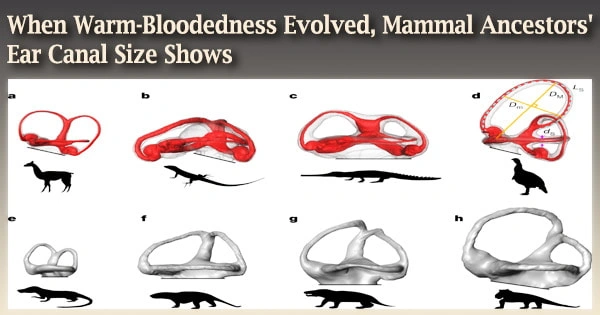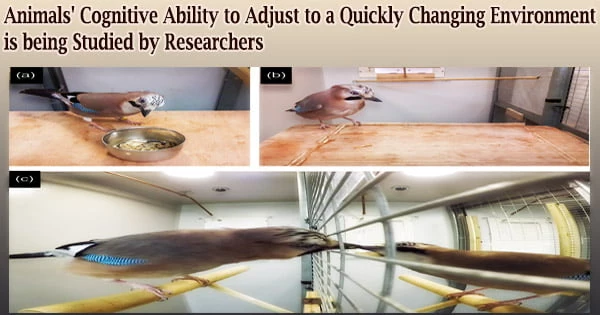A crucial characteristic of mammals, warm-bloodedness has remained a mystery since its evolution in our ancestors. According to a recent study published in Nature, the size of the microscopic structures in an animal’s inner ears can be used to estimate the body temperature of a fossilized species.
Animals with warm bodies don’t need as large ear canals since the fluid in our ears becomes runnier at higher temperatures. It turns out that mammals evolved into warm-blooded creatures roughly 20 million years later than originally believed.
Being warm-blooded is one of the characteristics that distinguish mammals. Unlike cold-blooded animals like lizards, who must spend time in the sun to maintain their internal temperature, our bodies have high metabolisms that enable us to remain warm regardless of our environment.
Only mammals and birds are warm-blooded species in the current animal kingdom, and our capacity to stay warm has allowed mammals to endure frigid conditions and undertake lengthy migrations. However, the precise time when mammals developed their fast metabolisms has remained unknown.
In a recent study published in Nature, researchers use an unexpected source for dating the evolution of warm-blooded mammals: the dimensions of the inner ear components.
It’s difficult to determine whether a fossilized animal was warm-blooded because we can’t monitor its temperature and we can only speculate on whether the animal’s activity fit a warm-blooded metabolism that was active or one that was slower.
However, a group of scientists led by the Natural History Museum in London, the Instituto Superior Técnico at the University of Lisbon, and the Field Museum in Chicago discovered that animal ears give a subtly accurate indication of their body temperatures.
The origin of mammalian endothermy is one of the great unsolved mysteries of paleontology. Many different approaches have been used to try to predict when it first evolved, but they have often given vague or conflicting results.
Ken Angielczyk
All vertebrate animals have small canals in their ears that are filled with fluid to aid with balance. Our inner ears have developed varied diameters so that the fluid can flow properly since the viscosity, or runniness, of that fluid changes depending on temperature.
Warm-blooded species have runnier ear fluid, whereas cold-blooded animals’ ear fluid is cooler and thicker, requiring bigger passageways for it to pass through. As a result, our semicircular canals don’t need to be as large.
“Until now, semicircular canals were generally used to predict locomotion of fossil organisms. However, by carefully looking at their biomechanics, we figured that we could also use them to infer body temperatures,” says Romain David, a post-doctoral researcher at the Natural History Museum and one of the study’s lead authors.
“This is because, like honey, the fluid contained inside semicircular canals gets less viscous when temperature increases, impacting function. Hence, during the transition to endothermy, morphological adaptations were required to keep optimal performances, and we could track them in mammal ancestors.”
The researchers analyzed the inner ear canal widths of 341 animals, including 243 current species and 64 extinct ones, to chart these evolutionary variations. They discovered that mammals evolved the types of inner ear structures necessary for warm-blooded creatures only 233 million years ago, as opposed to the 20 million years that scientists had previously assumed warm-bloodedness evolved.
And it appears that when mammal ancestors did evolve warm-bloodedness, it happened much more quickly than scientists had thought, around the same time that proto-mammals started to evolve whiskers, fur, and specialized backbones, based on when those variously sized semicircular canals appeared in the fossil record.
Given that fur traps the body heat produced by a higher metabolism and helps maintain the body at the high temperature it needs to flourish, the evolution of fur and warm-bloodedness at roughly the same period makes the most sense.
“Contrary to current scientific thinking, our paper surprisingly demonstrates that the acquisition of endothermy seems to have occurred very quickly in geological terms, in less than a million years,” says Ricardo Araújo, junior researcher at Instituto de Plasmas e Fusão Nuclear, Instituto Superior Técnico, University of Lisbon and one of the paper’s lead authors.
“It was not a gradual, slow process over tens of millions of years as previously thought, but maybe was attained quickly when triggered by novel mammal-like metabolic pathways and origin of fur.”
The study’s senior author, Ken Angielczyk, says he’s excited by how the study helps answer one of the longest-standing questions about the evolution of mammals.
“The origin of mammalian endothermy is one of the great unsolved mysteries of paleontology. Many different approaches have been used to try to predict when it first evolved, but they have often given vague or conflicting results,” says Angielczyk, the Field Museum’s MacArthur Curator of Paleomammalogy.
“We think our method shows real promise because it has been validated using a very large number of modern species, and it suggests that endothermy evolved at a time when many other features of the mammalian body plan were also falling into place.”
















